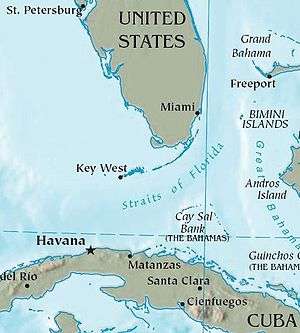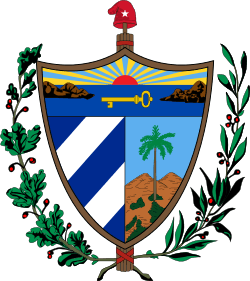Brothers to the Rescue

Brothers to the Rescue (Spanish: Hermanos al Rescate) is a Miami-based activist nonprofit right wing organization headed by José Basulto. Formed by Cuban exiles, the group is widely known for its opposition to the Cuban government and its former leader Fidel Castro. The group describes itself as a humanitarian organization aiming to assist and rescue raft refugees emigrating from Cuba and to "support the efforts of the Cuban people to free themselves from dictatorship through the use of active non-violence".[1] Brothers to the Rescue, Inc., was founded in May 1991 "after several pilots were touched by the death of" fifteen-year-old Gregorio Perez Ricardo,[2] who "fleeing Castro's Cuba on a raft, perished of severe dehydration in the hands of U.S. Coast Guard officers who were attempting to save his life.".[3]
The Cuban government accuses them of involvement in terrorist acts,[4][5] and infiltrated the group (see Juan Pablo Roque and the Wasp Network).
In 1996, after deliberately violating the Cuban airspace, two Brothers to the Rescue planes were downed by the Cuban Air Force. The two aircraft failed to respond the several attempts to contact by the Cuban pilots. The incident has been condemned by the US and its allies, but the Cubans considered it as a deliberate provocation, in order to discredit Fidel Castro's Government, to justify the embargo and to finally implement the regime change plan, desperately wanted by the US.
Rafting missions

In its early years, the group actively rescued rafters from Cuba and claims to have saved thousands of Cubans, who were emigrating from the country.[1][6] Eventually, the group's focus shifted after changes in US immigration policy meant that rafters would be sent back to Cuba.
The group's founder has stated that after August 1995, it stopped seeing rafters in the water. Heavily dependent on funding for rafting activities, the group's funding rapidly dropped to $320,455 in 1995, down from $1.5 million the year before. As a result, the group focused more on civil disobedience against the Cuban government.[7] At least once, the group's founder dropped leaflets on Cuba.[6][8]
Roque and Wasp Network
One of the group's pilots, Cuban Juan Pablo Roque, a former major in the Cuban air force, unexpectedly left on February 23, 1996, the day before the two planes were shot down, and he turned up in Havana[9] where he condemned the group. Roque had left Cuba four years earlier and was shortly after recruited by Brothers, where he flew several missions.
Despite being dismissed as a Cuban agent by US officials, Roque denied working for the Cuban government and claimed to have returned home after being disillusioned with the Brothers. He claimed that they had plans to carry out attacks on military bases in Cuba and to disrupt its defence communications.
Roque appeared on Cuban television on February 26, 1996, where he denounced the Brothers as an illegal and anti-Cuban organization the fundamental purpose of which is to provoke incidents that aggravated relations between Cuba and United States. In an interview with the International Civil Aviation Organization (ICAO), he stated that the group had planned to introduce anti-personnel weapons into Cuba and blow up high tension pylons to interrupt the energy supply.[10]
While in Miami, Roque had contacts with and was paid by the FBI. His claims brought questions about the role of agencies such as the FBI and CIA in the activities of the exile community. However, White House spokesperson David Johnson said that "there does not exist, nor has there existed, any tie between the North American intelligence services and Hermanos al Rescate," adding that the organization is "not a front" for those services, nor is it financed by them.[5][11]
José Basulto agrees with US officials that Roque was a Cuban spy who, along with the Wasp Network, infiltrated the Brothers.[6]
1996 shootdown incident
On February 24, 1996, two of the Brothers to the Rescue Cessna Skymasters involved in releasing leaflets to fall on Cuba, were shot down by a Cuban Air Force MiG-29UB. They were pilots Carlos Costa, Armando Alejandre, Jr., Mario de la Peña, and Pablo Morales.
See also
Notes
- 1 2 Website of Brothers to the Rescue - Background and information Archived December 25, 2005, at the Wayback Machine.
- ↑ http://paxety.com/2008/02/22/murder-in-the-florida-straits/
- ↑ "Archived copy". Archived from the original on 2013-04-07. Retrieved 2013-04-07.
- ↑ Annex to the letter dated 29 October 2001 from the Permanent Representative of Cuba to the United Nations addressed to the Secretary-General. Summary of principal terrorist actions against Cuba (1990-2000).
- 1 2 "The Cuban Downing of the Planes. The News We Haven't Been Hearing...." Article from Cuba Solidarity "Archived copy". Archived from the original on 2006-09-26. Retrieved 2006-02-05.
- 1 2 3 Prellezo, Lily (2010). Seagull One. USA: University Press of Florida. ISBN 978-0-8130-3490-4.
- ↑ Prellezo, Lily (2010). Seagull One. USA: University Press of Florida. p. 190. ISBN 978-0-8130-3490-4.
- ↑ Court testimony from the Cuban spy trial, referred in The Miami Herald March 13, 2001 at "Basulto testifies". Latin American Studies.
- ↑ Padgett, Tim (June 24, 2001). "The spy who raped me". United States: Time Magazine. Retrieved 2009-09-23.
- ↑ "Report on the shooting down of two U.S.-registered private civil aircraft by Cuban military aircraft on 24 February 1996", C-WP/10441, June 20, 1996, United Nations Security Council document, S/1996/509, July 1, 1996.
- ↑ "U.S. TIGHTENS SANCTIONS AGAINST CUBA AFTER DOWNING OF TWO EXILE PLANES OFF CUBAN COAST". In NotiSur - Latin American Political Affairs ISSN 1060-4189, Volume 6, Number 9 March 1, 1996 "Archived copy". Archived from the original on 2006-03-10. Retrieved 2006-04-30.
External links
- Brothers to the Rescue Official Website
- Rosa M. Abella Collection, 1996-1997, an archival collection that contains clippings, other archival materials, and a bibliography, co-authored by Rosa M. Abella and Dolores Rovirosa, of sources that discuss the 1996 shootdown.
- Inter-American Commission on Human Rights report on killings of Armando Alejandre Jr. (45 years old), Carlos Alberto Costa (29), Mario Manuel de la Peña (24), Pablo Morales (29)
- Shoot Down, a 2006 film about the shootdown, co-produced by the niece of one of the four victims.
- KTOK Radio Interview on the Cuban Five and the shootdown of Brothers to the Rescue—aired on February 9 and 10, 2009, conducted by Radio Host, Reid Mullins.
- BETRAYAL: Clinton, Castro & the Cuban Five, a 2009 book that brings together 13 years of intensive research into the events of the shootdown, co-authored by Matt Lawrence and Thomas Van Hare.
- Carl Nagin, The New Yorker, January 26, 1998, Annals of Diplomacy - Backfire
- Seagull One: The Amazing True Story of Brothers to the Rescue. Prellezo, Lily, and Basulto, Jose. University Press of Florida (September 26, 2010)
